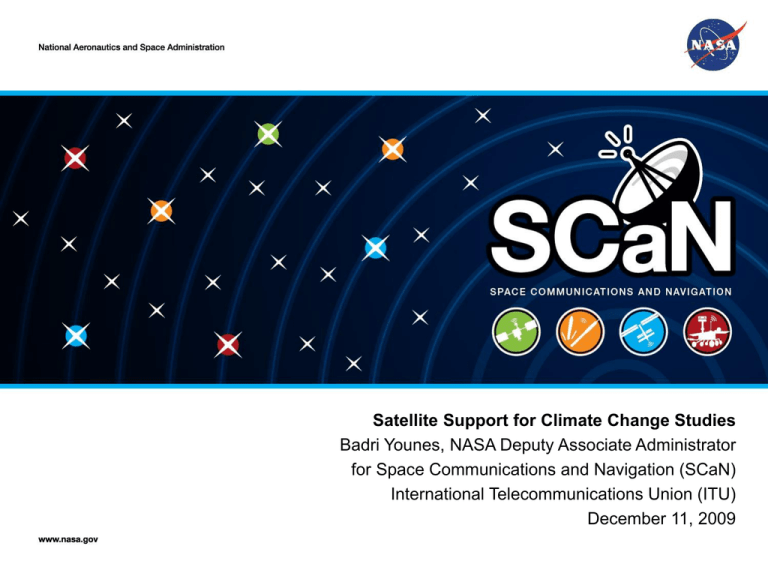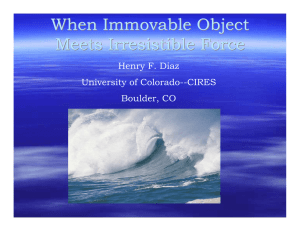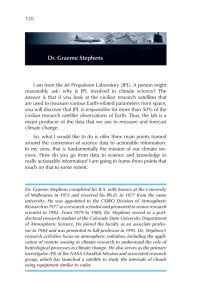Satellite Support For Climate Change Studies
advertisement

Satellite Support For Climate Change Studies Satellite Support for Climate Change Studies Badri Younes, NASA Deputy Associate Administrator for Space Communications and Navigation (SCaN) International Telecommunications Union (ITU) December 11, 2009 1 Overview Satellites provide the only platforms capable of covering the entire earth (note swaths do not overlap) with the same instrument and providing temporal well as spatial coverage. Further, using the same instrument, rather than copies, insures consistent data. 2 Overview Considering alternative methods – multiple ground stations, multiple rocket launches, multiple ships and aircraft on station, etc.Satellites are the most cost-effective way of monitoring the state and health of our planet – without having to constantly cross-calibrate a vast collection of similar, or different, instruments.. 3 Overview 4 Overview Examples shown previously include: Biosphere production Aerosols Radiant Energy Air Pollution Temperature Water Vapour There are others; all pertinent to monitoring the state, and the health, of our planet. 5 Satellites Monitor Parameters Globally 6 Population Monitoring Night lights visible from space indicate populated areas 7 Population Monitoring Population model based on proximity to roads, slope*, land cover*, Fires in Guatemala and Mexico nighttime lights*, and other information. (*from satellite data) 8 Satellite-Derived Land Usage 9 Seasonal Land Cover Change 10 Deforestation 11 Desertification Reversed 1987 – Drought, agriculture and overgrazing pushed an area towards desertification. 1999 – Sidi Toui National Park (Tunisia) established in 1993 and fenced, native Grassland revived (winter image). 12 Plant Health - August 13 Plant Health - February 14 Biosphere Productivity Dan Irwin’s Presentation of SERVIR to the Presidents of Central America and Mexico 15 Arctic Sea Ice Mapping 16 Daily Arctic Sea Ice – Summer 2009 17 Arctic Sea Ice Trends Seasonal Minimum Arctic Sea Ice Extent 18 Greenland's Ice Fields Greenland's ice fields have also been mapped and its ice flows identified – with satellite-borne Radar 19 Monitoring Greenland's Ice Flow Satellite Radar Techniques are Confirmed by GPS on-ice Measurements 20 Antarctic Ice Cap Map RADARSAT produced the first image of all of Antarctica 21 Antarctic Ice Cap Flows Additional Observations produced Ice flow Maps 22 Global Topology – Areas at Risk Shuttle Radar Topology Mission covered between +/- 60° latitude and penetrated most of the vegetation and all of the clouds. 23 Global Topology – Areas at Risk ASTER on TERRA covered between +/- 83° latitude but did not penetrate vegetation or clouds. 24 Weather Prediction and Climate Variables Geosynchronous Weather Satellites Track Weather Systems worldwide 25 Ozone – Action Needed A Growing Antarctic Ozone “hole” admitted more UV to the Southern Hemisphere 26 Ozone – Action Taken The Montreal Protocol, effective Jan. 1, 1989, reduced global CFC production 27 Ozone – Results 28 Summary Satellites provide data necessary to monitor environmental change over the entire globe, including climate change. Radio Spectrum is required to return data from ALL environment-monitoring satellites, regardless of their instrumentation. Radio Spectrum is necessary to provide unique observations of some environmental parameters and is critical to monitoring polar regions. 29






